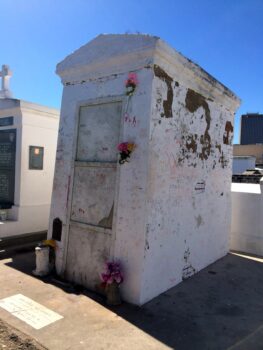Since Marie Laveau, the legendary Voodoo priestess of 19th-century New Orleans, passed away in 1881, her tomb has become a site of pilgrimage. Visitors flock to St. Louis Cemetery No. 1, carving X’s into the stone in hopes that she will grant their wishes.
A Venerated Site

Each year, thousands make the journey to Marie Laveau’s resting place in New Orleans, drawn by her reputation as the “Voodoo Queen.” A prominent community leader, healer, and spiritual advisor, Laveau ran a beauty parlor that connected her with the city’s elite, offering counsel on matters ranging from domestic troubles to health issues.
The Legacy of Marie Laveau
After her death, she was laid to rest in a tomb within the oldest cemetery in the city. Since then, admirers have honored her memory with offerings, symbols, and rituals, seeking her blessings. Unfortunately, this well-meaning homage has led to significant damage to her tomb. Nearly 150 years later, her fans continue to visit, hoping for her magic to transcend the grave.
The Life and Legacy of Marie Laveau

Marie Laveau was born on September 10, 1801, in New Orleans’ French Quarter. Her exact heritage is debated, but many historians believe she was the daughter of Marguerite D’Arcantel, a free woman of African descent, and Charles Laveau, the son of a notable Creole politician. Other theories suggest her father was Charles Laveaux, a free Black man.
Early Life and Marriages
On August 4, 1819, Laveau married Jacques Paris, a Creole man from Haiti. The couple had two children, both of whom died young. After Paris vanished from historical records in the early 1820s, Laveau entered a long-term relationship with Jean Louis Christophe Duminy de Glapion, with whom she had at least seven children. Today, they are believed to be interred together in her tomb.
Reputation and Influence
Although Laveau was a respected member of the Catholic community, her reputation as a Voodoo practitioner grew during her life. An 1871 article in the New Orleans Republican referred to her as “a good Christian woman” who was mistakenly labeled a “Voudou priestess.” However, Laveau did perform rituals and provided clients with gris-gris—protective charms made from herbs, oils, and other materials. As a hairdresser, she offered guidance on personal, legal, and financial matters.
Rise to Prominence
Her influence expanded, earning her the title of New Orleans’ “Voodoo Queen.” When she died on June 15, 1881, the city mourned her loss with a grand funeral. “Her remains were followed to the grave by a large concourse of people, the most prominent and the most humble joining in paying their last respects to the dead,” reported The Times-Picayune at the time.
Marie Laveau’s Tomb in St. Louis Cemetery

While the exact location of the Voodoo Queen’s burial is not definitively established, it is believed that she rests in the Glapion family crypt within St. Louis Cemetery No. 1. Following her passing, followers began to visit her tomb, leaving offerings such as alcohol, flowers, Mardi Gras beads, and food.
Rituals and Offerings
“Visitors come almost daily to make offerings to Marie’s spirit,” noted 19th-century sextons Raymond Rivaros and Ayola Cruz in Carolyn Long’s book A New Orleans Voudou Priestess: The Legend and Reality of Marie Laveau. They would create crosses with red bricks, charcoal, and sharp rocks, and knock three times on the marble slab as part of their rituals.
The Legend of the X’s
At some point, a rumor emerged that drawing an X on Marie Laveau’s tomb would grant wishes. This practice became widespread, leading to the tomb being covered with X’s, both painted and carved into the stone.
Recent Vandalism and Restoration Efforts
In December 2013, a vandal painted the tomb bright pink, prompting a restoration effort by the Archdiocese of New Orleans and a non-profit organization, Save Our Cemeteries. Over three months in 2014, workers struggled to protect the freshly restored tomb from further vandalism. “Initially, we hoped for the best and put caution tape around the tomb,” Michelle Duhon, owner of Bayou Preservation, recalled. “We even wrapped it in plastic, but people cut through that.”
The Ongoing Challenge of Preservation
Despite efforts to shield the site, the vandalism persisted, resulting in the cemetery being closed to the public. Now, visitors can only enter with an official tour guide. Guide Nancy Landry remarked, “It doesn’t make any sense. You wouldn’t travel to Egypt and do some hokey-pokey with King Tut’s pyramid, so why would you do that with a queen or a Voodoo priestess?”
A Continued Legacy
Despite the challenges, around 200,000 people visit Marie Laveau’s tomb annually, paying their respects to the Voodoo Queen of New Orleans. Her enduring legacy continues to attract those seeking connection with her spirit, reflecting the complex relationship between cultural reverence and the impact of modern tourism.


